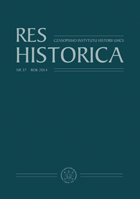Rozwój sieci kolegiów w litewskiej prowincji pijarów w XVIII w.
The Development of the Collegial Network in the Lithuanian Piarist Province in the 18th Century
Author(s): Mariusz AuszSubject(s): Cultural history, Social history, History of Education, 18th Century, Sociology of Education
Published by: Wydawnictwo Naukowe Uniwersytetu Marii Curie-Sklodowskiej
Keywords: Piarists; Piarist collegia; education; Lithuanian Piarist Province;
Summary/Abstract: This article presents the problem of the development Piarist collegia in the Lithuanian province. The Piarists arrived in the Polish-Lithuanian Commonwealth in 1642. Until 1662, the Polish Piarist collegia belonged to the German province because only then a separate Polish province that had been established – a part of which also included the Hungarian vice-province – was approved by Pope Alexander VII. Thirty years later (in 1692) the Hungarian collegia formed their own province. In 1696, The Order’s authorities constituted the Lithuanian vice-province, and in 1736 a separate Lithuanian province. The fi rst Lithuanian provincial was Franciszek Torkwat Tyminski. In the second half of the 18th century, it included the following monastic houses: Lithuanian Ščučyn, Lida, Vilnius (Collegium Nobilium, in 1774 the Piarists additionally took over the Jesuit monastery – Church of St. Raphael in Šnipiškės), Lužki, Ukmergė, Raseiniai, Liubeshiv, Dąbrowica, Panevėžys, Zelwa, Vitebsk, Dubrowna. After 1795, the collegium in Mezhirichi – which was the only one from the Polish province. Unfortunately, the collapse of the November Uprising marked the end of the Piarist education.
Journal: Res Historica
- Issue Year: 2023
- Issue No: 56
- Page Range: 205-224
- Page Count: 20
- Language: Polish

